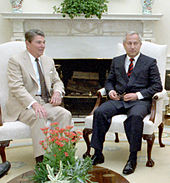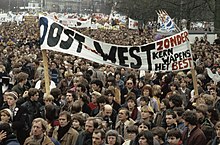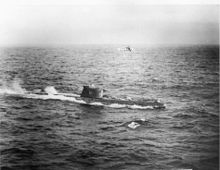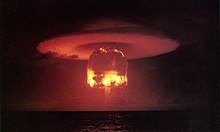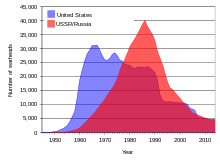Nuclear warfare is a common theme of World War III scenarios. Such a conflict has been hypothesised to result in human extinction.
World War III (WWIII or WW3) and the Third World War are names given to a hypothetical third worldwide large-scale military conflict subsequent to World War I and World War II.
The term has been in use since at least as early as 1941. Some have
applied it loosely to refer to limited or smaller conflicts such as the Cold War or the War on Terror, while others assumed that such a conflict would surpass prior world wars both in its scope and in its destructive impact.
Due to the development and use of nuclear weapons near the end of World War II and their subsequent acquisition and deployment by many countries,
the potential risk of a nuclear devastation of Earth's civilization and
life is a common theme in speculations about a Third World War. Another
major concern is that biological warfare
could cause a very large number of casualties, either intentionally or
inadvertently by an accidental release of a biological agent, the
unexpected mutation of an agent, or its adaptation to other species
after use. High-scale apocalyptic events like these, caused by advanced technology used for destruction, could potentially make the Earth's surface uninhabitable.
Prior to the beginning of the Second World War, the First World War (1914–1918) was believed to have been "the war to end all wars," as it was popularly believed that never again could there possibly be a global conflict of such magnitude. During the interwar period, WWI was typically referred to simply as "The Great War." The outbreak of World War II in 1939 disproved the hope that mankind might have already "outgrown" the need for such widespread global wars.
With the advent of the Cold War in 1945 and with the spread of nuclear weapons technology to the Soviet Union,
the possibility of a third global conflict became more plausible.
During the Cold War years, the possibility of a Third World War was
anticipated and planned for by military and civil authorities in many
countries. Scenarios ranged from conventional warfare to limited or total nuclear warfare. At the height of the Cold War, a scenario referred to as Mutually Assured Destruction
("MAD") had been calculated which determined that an all-out nuclear
confrontation would most certainly destroy all or nearly all human life
on the planet. The potential absolute destruction of the human race may
have contributed to the ability of both American and Soviet leaders to
avoid such a scenario.
Coinage
Time magazine
Time magazine was an early adopter if not originator of the term "World War III". Perhaps the first usage appears in its 3 November 1941, issue (preceding the Japanese attack on Pearl Harbor on 7 December 1941) under its "National Affairs" section and entitled "World War III?" about Nazi refugee Dr. Hermann Rauschning, who had just arrived in the United States. In its 22 March 1943, issue under its "Foreign News" section, Time reused the same title "World War III?" with regard to statements by then-U.S. Vice President Henry A. Wallace: "We shall decide some time in 1943 or 1944 ... whether to plant the seeds of World War III." Time continued to entitle with or mention in stories the term "World War III" for the rest of the decade (and onwards): 1944, 1945, 1946 ("bacterial warfare"), 1947, and 1948. (Time persists in using this term, e.g., this 2015 book review, entitled "This Is What World War III Will Look Like.")
Military plans
Military planners have been war gaming various scenarios, preparing
for the worst, since the early days of the Cold War. Some of those plans
are now out of date and have been partially or fully declassified.
Operation Unthinkable
British Prime Minister Winston Churchill
was concerned that, with the enormous size of Soviet forces deployed in
Europe at the end of WWII and the unreliability of the Soviet leader Joseph Stalin, there was a serious threat to Western Europe. In April–May 1945, British Armed Forces developed Operation Unthinkable, thought to be the first scenario of the Third World War. Its primary goal was "to impose upon Russia the will of the United States and the British Empire". The plan was rejected by the British Chiefs of Staff Committee as militarily unfeasible.
Operation Dropshot
"Operation Dropshot" was the 1950s United States contingency plan for a possible nuclear and conventional war with the Soviet Union in the Western European and Asian theaters.
At the time the US nuclear arsenal was limited in size, based
mostly in the United States, and depended on bombers for delivery.
"Dropshot" included mission profiles that would have used 300 nuclear
bombs and 29,000 high-explosive bombs on 200 targets in 100 cities and
towns to wipe out 85% of the Soviet Union's industrial potential at a
single stroke. Between 75 and 100 of the 300 nuclear weapons were
targeted to destroy Soviet combat aircraft on the ground.
The scenario was devised prior to the development of intercontinental ballistic missiles. It was also devised before U.S. President John F. Kennedy and his Secretary of Defense Robert McNamara
changed the US Nuclear War plan from the 'city killing' countervalue
strike plan to a "counterforce" plan (targeted more at military forces).
Nuclear weapons at this time were not accurate enough to hit a naval
base without destroying the city adjacent to it, so the aim in using
them was to destroy the enemy industrial capacity in an effort to
cripple their war economy.
Exercises Grand Slam, Longstep, and Mainbrace
In January 1950, the North Atlantic Council approved NATO's military strategy of containment. NATO military planning took on a renewed urgency following the outbreak of the Korean War
in the early 1950s, prompting NATO to establish a "force under a
centralised command, adequate to deter aggression and to ensure the
defence of Western Europe". Allied Command Europe was established under General of the Army Dwight D. Eisenhower, US Army, on 2 April 1951. The Western Union Defence Organization had previously carried out Exercise Verity, a 1949 multilateral exercise involving naval air strikes and submarine attacks.
Exercise Mainbrace brought together 200 ships and over 50,000
personnel to practice the defence of Denmark and Norway from Russian
attack in 1952. It was the first major NATO exercise. The exercise was
jointly commanded by Supreme Allied Commander Atlantic Admiral Lynde D. McCormick, USN, and Supreme Allied Commander Europe General Matthew B. Ridgeway, US Army, during the autumn of 1952.
The US, UK, Canada, France, Denmark, Norway, Portugal, Netherlands, and Belgium all participated.
Exercises Grand Slam and Longstep were naval exercises held in
the Mediterranean Sea during 1952 to practice dislodging an enemy
occupying force and amphibious assault. It involved over 170 warships
and 700 aircraft under the overall command of Admiral Carney. The
overall exercise commander, Admiral Carney summarized the
accomplishments of Exercise Grand Slam by stating: "We have demonstrated
that the senior commanders of all four powers can successfully take
charge of a mixed task force and handle it effectively as a working
unit."
The USSR called the exercises "war-like acts" by NATO, with particular reference to the participation of Norway and Denmark, and prepared for its own military maneuvers in the Soviet Zone.
Operation Strikeback
This was a major NATO naval exercise held in 1957, simulating a
response to an all-out Soviet attack on NATO. The exercise involved over
200 warships, 650 aircraft, and 75,000 personnel from the United States Navy, the United Kingdom's Royal Navy, the Royal Canadian Navy, the French Navy, the Royal Netherlands Navy, and the Royal Norwegian Navy. As the largest peacetime naval operation up to that time, Operation Strikeback was characterized by military analyst Hanson W. Baldwin of The New York Times as "constituting the strongest striking fleet assembled since World War II".
Exercise Reforger
If activated, Operation Reforger would have largely consisted of convoys like this one from Operation Earnest Will
in 1987, although much larger. While troops could easily fly across the
Atlantic, the heavy equipment and armor reinforcements would have to
come by sea.
Exercise Reforger (from return of forces to Germany) was an annual exercise conducted, during the Cold War, by NATO.
The exercise was intended to ensure that NATO had the ability to
quickly deploy forces to West Germany in the event of a conflict with
the Warsaw Pact.
The Warsaw Pact outnumbered NATO throughout the Cold War in conventional
forces, especially armor. Therefore, in the event of a Soviet invasion,
in order not to resort to tactical nuclear strikes, NATO forces holding
the line against a Warsaw Pact armored spearhead would have to be
quickly resupplied and replaced. Most of this support would have come
across the Atlantic from the US and Canada.
Reforger was not merely a show of force—in the event of a
conflict, it would be the actual plan to strengthen the NATO presence in
Europe. In that instance, it would have been referred to as Operation
Reforger. Important components in Reforger included the Military Airlift Command, the Military Sealift Command, and the Civil Reserve Air Fleet.
Seven Days to the River Rhine
A Warsaw Pact invasion would have come via three main paths through West Germany.
Seven Days to the River Rhine was a top-secret military simulation
exercise developed in 1979 by the Warsaw Pact. It started with the
assumption that NATO would launch a nuclear attack on the Vistula river valley in a first-strike scenario, which would result in as many as two million Polish civilian casualties. In response, a Soviet counter-strike would be carried out against West Germany, Belgium, the Netherlands and Denmark,
with Warsaw Pact forces invading West Germany and aiming to stop at the
River Rhine by the seventh day. Other USSR plans stopped only upon
reaching the French border on day nine. Individual Warsaw Pact states
were only assigned their own subpart of the strategic picture; in this
case, the Polish forces were only expected to go as far as Germany. The
Seven Days to the Rhine plan envisioned that Poland and Germany would be
largely destroyed by nuclear exchanges, and that large numbers of
troops would die of radiation sickness.
It was estimated that NATO would fire nuclear weapons behind the
advancing Soviet lines to cut off their supply lines and thus blunt
their advance. While this plan assumed that NATO would use nuclear
weapons to push back any Warsaw Pact invasion, it did not include
nuclear strikes on France or the United Kingdom. Newspapers speculated
when this plan was declassified, that France and the UK were not to be
hit in an effort to get them to withhold use of their own nuclear
weapons.
Exercise Able Archer
President Ronald Reagan and Soviet double agent Oleg Gordievsky, who later told the west how close the Able Archer 83 exercise had brought the Soviets to ordering a First Strike.
Exercise Able Archer was an annual exercise by the United States
military in Europe that practised command and control procedures, with
emphasis on the transition from solely conventional operations to
chemical, nuclear, and conventional operations during a time of war.
"Able Archer 83" was a five-day North Atlantic Treaty Organization (NATO) command post exercise starting on 7 November 1983, that spanned Western Europe, centered on the Supreme Headquarters Allied Powers Europe (SHAPE) Headquarters in Casteau, north of the city of Mons. Able Archer exercises simulated a period of conflict escalation, culminating in a coordinated nuclear attack.
The realistic nature of the 1983 exercise, coupled with deteriorating relations between the United States and the Soviet Union and the anticipated arrival of strategic Pershing II nuclear missiles in Europe, led some members of the Soviet Politburo and military to believe that Able Archer 83 was a ruse of war, obscuring preparations for a genuine nuclear first strike. In response, the Soviets readied their nuclear forces and placed air units in East Germany and Poland on alert.
This "1983 war scare" is considered by many historians to be the closest the world has come to nuclear war since the Cuban Missile Crisis of 1962. The threat of nuclear war ended with the conclusion of the exercise on 11 November, however.
Strategic Defense Initiative
The Strategic Defense Initiative (SDI) was proposed by U.S. President Ronald Reagan on 23 March 1983. In the latter part of his presidency, numerous factors (which included watching the 1983 movie The Day After and hearing through a Soviet defector that Able Archer 83 almost triggered a Russian first strike) had turned Ronald Reagan against the concept of winnable nuclear war, and he began to see nuclear weapons as more of a "wild card"
than a strategic deterrent. Although he later believed in disarmament
treaties slowly blunting the danger of nuclear weaponry by reducing
their number and alert status, he also believed a technological solution
might allow incoming ICBMs to be shot down, thus making the US
invulnerable to a first strike. However, the USSR saw the SDI concept as
a major threat, since a unilateral deployment of the system would allow
the US to launch a massive first strike on the Soviet Union without any
fear of retaliation.
The SDI concept was to use ground-based and space-based systems to protect the United States from attack by strategic nuclear ballistic missiles. The initiative focused on strategic defense rather than the prior strategic offense doctrine of Mutual Assured Destruction (MAD). The Strategic Defense Initiative Organization (SDIO) was set up in 1984 within the United States Department of Defense to oversee the Strategic Defense Initiative.
NATO nuclear sharing
NATO operational plans for a Third World War have involved NATO
allies who do not have their own nuclear weapons, using nuclear weapons
supplied by the United States as part of a general NATO war plan, under
the direction of NATO's Supreme Allied Commander.
Protest in Amsterdam against the nuclear arms race between the U.S./NATO and the Soviet Union, 1981
Of the three nuclear powers in NATO (France, the United Kingdom, and the United States) only the United States has provided weapons for nuclear sharing. As of November 2009, Belgium, Germany, Italy, the Netherlands and Turkey are still hosting US nuclear weapons as part of NATO's nuclear sharing policy. Canada hosted weapons until 1984, and Greece until 2001. The United Kingdom also received US tactical nuclear weapons such as nuclear artillery and Lance missiles until 1992, despite the UK being a nuclear weapons state in its own right; these were mainly deployed in Germany.
In peacetime, the nuclear weapons stored in non-nuclear countries are guarded by US airmen
though previously some artillery and missile systems were guarded by US
Army soldiers; the codes required for detonating them are under
American control. In case of war, the weapons are to be mounted on the
participating countries' warplanes. The weapons are under custody and
control of USAF Munitions Support Squadrons co-located on NATO main operating bases who work together with the host nation forces.
As of 2005, 180 tactical B61 nuclear bombs of the 480 US nuclear weapons believed to be deployed in Europe fall under the nuclear sharing arrangement. The weapons are stored within a vault in hardened aircraft shelters, using the USAF WS3 Weapon Storage and Security System. The delivery warplanes used are F-16s and Panavia Tornados.
Historical close calls
With the initiation of the Cold War arms race in the 1950s, an apocalyptic
war between the United States and the Soviet Union became a real
possibility. During the Cold War era (1947–1991), a number of military
events have been described as having come quite close to potentially
triggering World War III.
Korean War: 25 June 1950 – 27 July 1953
The Korean War was a war between two coalitions fighting for control over the Korean Peninsula:
a communist coalition including North Korea, China and the USSR, and a
capitalist coalition including South Korea, the United States, and the
UN. Many then believed that the conflict was likely to soon escalate
into a full-scale war between the three countries, the US, the USSR, and
China. CBS war correspondent Bill Downs wrote in 1951 that, "To my mind, the answer is: Yes, Korea is the beginning of World War III. The brilliant landings at Inchon
and the cooperative efforts of the American armed forces with the
United Nations Allies have won us a victory in Korea. But this is only
the first battle in a major international struggle which now is
engulfing the Far East and the entire world." Downs afterwards repeated this belief on ABC Evening News while reporting on the USS Pueblo incident in 1968.
Cuban Missile Crisis: 15–28 October 1962
A US Navy HSS-1 Seabat helicopter hovers over Soviet submarine B-59,
forced to the surface by US Naval forces in the Caribbean near Cuba.
B-59 had a nuclear torpedo on board, and three officer keys were
required to use it. Only one dissent prevented the submarine from
attacking the US fleet nearby, a spark that could have led to a Third
World War ( 28–29 October 1962).
The Cuban Missile Crisis: a confrontation on the stationing of Soviet nuclear missiles in Cuba, in response to the failed Bay of Pigs Invasion,
is considered as having been the closest to a nuclear exchange, which
could have precipitated a Third World War. The crisis peaked on 27
October, with three separate major incidents occurring on the same day,
all of these incidents having been initiated by the US military.
- The "Arkhipov save" incident occurred when a Soviet submarine nearly launched a nuclear-tipped torpedo in response to having been targeted by American naval depth charges in international waters, with the Soviet nuclear launch response only having being prevented by Soviet naval officer Vasily Arkhipov.
- The shooting down of a U-2 while violating Cuban airspace.
- The near interception of another U-2 that had somehow managed to stray into Soviet airspace over Siberia, which airspace violation nearly caused the Soviets to believe that this might be the vanguard of a US aerial bombardment.
Despite what many believe to be the closest the world has come to a nuclear conflict, throughout the entire standoff, the Doomsday Clock, which is run by the Bulletin of the Atomic Scientists
to estimate how close the end of the world, or doomsday, is, with
midnight being the apocalypse, stayed at a relatively stable seven
minutes to midnight. This has been explained as being due to the brevity
of the crisis, since the clock monitored more long term factors such as
leadership of countries, conflicts, wars, and political upheavals, as
well as societies reactions to said factors.
The Bulletin of the Atomic Scientists now credits the political
developments resulting from the Cuban Missile Crisis with having
actually enhanced global stability. The Bulletin posits that future
crises and occasions that might otherwise escalate, were rendered as
more stable due to two major factors:
- A Washington to Moscow direct telephone line, resulted from the communication trouble between the White House and the Kremlin during the crisis, giving the leaders of the two largest nuclear powers the ability to contact each other in real time, rather than sending written messages that needed to be translated and wired, which had dragged out conversations in which seconds could have potentially prevented a nuclear exchange.
- The second factor was caused in part due to the worldwide reaction to how close the US and USSR had come to the brink of World War III during the standoff. As the public began to more closely monitor topics involving nuclear weapons, and therefore to rally support for the cause of non-proliferation, the 1963 test ban treaty was signed. To date this treaty has been signed by 126 total nations, with the most notable exceptions being France and China. Both of these countries were still in the relative beginning stages of their nuclear programs at the time of the original treaty signing, and both sought nuclear capabilities independent of their allies.
-
- -This Test Ban Treaty prevented the testing of nuclear ordnance that detonated in the atmosphere, limiting testing to below ground and under water, decreasing fallout and effects on the environment, and subsequently caused the Doomsday Clock to decrease by five minutes, to arrive at a total of twelve minutes to midnight. Up until this point, over 1000 nuclear bombs had been detonated, and concerns over both long and short term affects to the planet became increasingly more worrisome to scientists.
Yom Kippur War super-power tensions: 6–25 October 1973
The Yom Kippur War,
also known as the Ramadan War, or October War, began with Arab
victories. Israel successfully counterattacked. Tensions grew between
the US (which supported Israel) and the Soviet Union (which sided with
the Arab states). American and Soviet naval forces came close to firing
upon each other. Admiral Murphy of the US reckoned the chances of the
Soviet squadron attempting a first strike against his fleet at 40
percent. The Pentagon moved Defcon status from 4 to 3. The superpowers had been pushed to the brink of war, but tensions eased with the ceasefire brought in under UNSC 339.
NORAD computer error of 1979: 9 November 1979
The United States made emergency retaliation preparations after NORAD
saw on-screen indications that a full-scale Soviet attack had been
launched. No attempt was made to use the "red telephone"
hotline to clarify the situation with the USSR and it was not until
early-warning radar systems confirmed no such launch had taken place
that NORAD realized that a computer system test had caused the display
errors. A senator inside the NORAD facility at the time described an
atmosphere of absolute panic. A GAO investigation led to the
construction of an off-site test facility to prevent similar mistakes.
"Petrov save" incident: 26 September 1983
A false alarm occurred on the Soviet nuclear early warning system, showing the launch of American Minuteman ICBMs from bases in the United States. A retaliatory attack was prevented by Stanislav Petrov,
an officer of the Soviet Air Defence Forces, who realised the system
had simply malfunctioned (which was borne out by later investigations).
Able Archer escalations: 2–11 November 1983
During Able Archer 83, a ten-day NATO exercise simulating a period of conflict escalation that culminated in a DEFCON 1 nuclear strike, some members of the Soviet Politburo and armed forces treated the events as a ruse of war concealing a genuine first strike.
In response, the military prepared for a coordinated counter-attack by
readying nuclear forces and placing air units stationed in the Warsaw Pact states of East Germany and Poland under high alert. However, the state of Soviet preparation for retaliation ceased upon completion of the Able Archer exercises.
Norwegian rocket incident: 25 January 1995
The Norwegian rocket incident is the only World War III close call to occur outside the Cold War. This incident occurred when Russia's Olenegorsk early warning station accidentally mistook the radar signature from a Black Brant XII research rocket (being jointly launched by Norwegian and US scientists from Andøya Rocket Range), as appearing to be the radar signature of the launch of a Trident SLBM missile. In response, Russian President Boris Yeltsin was summoned and the Cheget nuclear briefcase
was activated for the first and only time. However, the high command
was soon able to determine that the rocket was not entering Russian
airspace, and promptly aborted plans for combat readiness and
retaliation. It was retrospectively determined that, while the rocket
scientists had informed thirty states including Russia about the test
launch, the information had not reached Russian radar technicians.
Incident at Pristina airport: 12 June 1999
On 12 June 1999, the day following the end of the Kosovo War, some 250 of Russian peacekeeping troops occupied the Pristina International Airport ahead of the arrival of NATO troops and were to secure the arrival of reinforcements over the air. American NATO Supreme Allied Commander Europe General Wesley Clark ordered the use of force against the Russians. Mike Jackson,
British Army general who contacted the Russians during the incident,
refused to enforce Clark's orders, famously telling him "I'm not going
to start the Third World War for you." Captain James Blunt,
the lead officer at the front of the Nato column in the direct armed
stand-off against the Russians, received the "Destroy!" orders from
Clark over the radio, but he followed Jackson's orders to encircle the
airfield instead and later told in an interview that even without
Jackson's intervention he would have refused to follow Clark's order.
Extended usage of the term
Large nuclear weapons stockpile with global range (dark blue), smaller stockpile with global range (medium blue)
Cold War
As Soviet-American relations grew more tense in the post-World War II period, the fear that it could escalate into World War III was ever-present. A Gallup poll in December 1950 found that more than half of Americans considered World War III to have already started.
In 2004, commentator Norman Podhoretz proposed that the Cold War, lasting from the surrender of Japan and Germany until the fall of the Berlin Wall, might rightly be called World War III. By Podhoretz's reckoning, "World War IV" would be the global campaign against Islamofascism.
Still the majority of historians would seem to hold that World War III would necessarily have to be a worldwide "war in which large forces from many countries fought" and a war that "involves most of the principal nations of the world." In his book Secret Weapons of the Cold War,
Bill Yenne explains that the military standoff that occurred between
the two 'Superpowers', namely the United States and the Soviet Union,
from the 1940s through to 1991, was only the Cold War,
which ultimately helped to enable mankind to avert the possibility of
an all out nuclear confrontation, and that it certainly was not World
War III.
War on Terror
The "War on Terror" that began with the September 11 attacks has been claimed by some to be World War III or sometimes as World War IV.
Others have disparaged such claims as "distorting American history."
While there is general agreement amongst historians regarding the
definitions and extent of the first two world wars, namely due to the
unmistakable global scale of aggression and self-destruction of these
two wars, a few have claimed that a "World War" might now no longer
require such worldwide and large scale aggression and carnage. Still,
such claims of a new "lower threshold of aggression," that might now be
sufficient to qualify a war as a "World War" have not gained such
widespread acceptance and support as the definitions of the first two
world wars have received amongst historians.
War on ISIL
On 1 February 2015, Iraqi Foreign Minister Ibrahim al-Jaafari declared that the War on ISIL was effectively "World War III", due to ISIL's declaration of a Worldwide Caliphate, its aims to conquer the world, and its success in spreading the conflict to multiple countries outside of the Levant region.
In response to the November 2015 Paris attacks, King of Jordan Abdullah II said "We are facing a Third World War [within Islam]."
In his State of the Union Address on 12 January 2016, U.S. President Barack Obama
warned that news reports granting ISIL the supposed ability to foment
WW III might be excessive and irresponsible, stating that, "as we focus
on destroying ISIL, over-the-top claims that this is World War III
just play into their hands. Masses of fighters on the back of pickup
trucks and twisted souls plotting in apartments or garages pose an
enormous danger to civilians and must be stopped. But they do not
threaten our national existence."
Multiple small wars as a "third war"
In multiple recorded interviews under somewhat casual circumstances, comparing the conflagrations of World War I and II to the ongoing lower intensity wars of the 21st century, Pope Francis has said, "The world is at war, because it has lost peace," and "perhaps one can speak of a third war, one fought piecemeal."
Views on the likely outcome and definition
In 1949, after the unleashing of nuclear weaponry at the end of WWII, physicist Albert Einstein suggested that any outcome of a possible WWIII would be so dire as to revert mankind back to the Stone Age. When asked by journalist Alfred Werner, what types of weapons Einstein believed World War III might be fought with, Einstein warned, "I know not with what weapons World War III will be fought, but World War IV will be fought with sticks and stones".
In his book Destined for War, Graham Allison views the global rivalry between the established power, the US, and the rising power, China, as an example of the Thucydides Trap. Past examples have often led to war, and in this case World War Three is possible but not inevitable.



